The weeping willow lifespan is more than just a tree. It’s a living piece of art that can transform any landscape. But just how long can we expect these majestic trees to live? Understanding the weeping willow lifespan is crucial for anyone looking to plant one, as various factors can significantly affect its longevity.
In this guide, we’ll uncover the secrets to a long and healthy life for your willow, providing you with practical advice to help it flourish for decades to come.
Understanding the Weeping Willow Tree
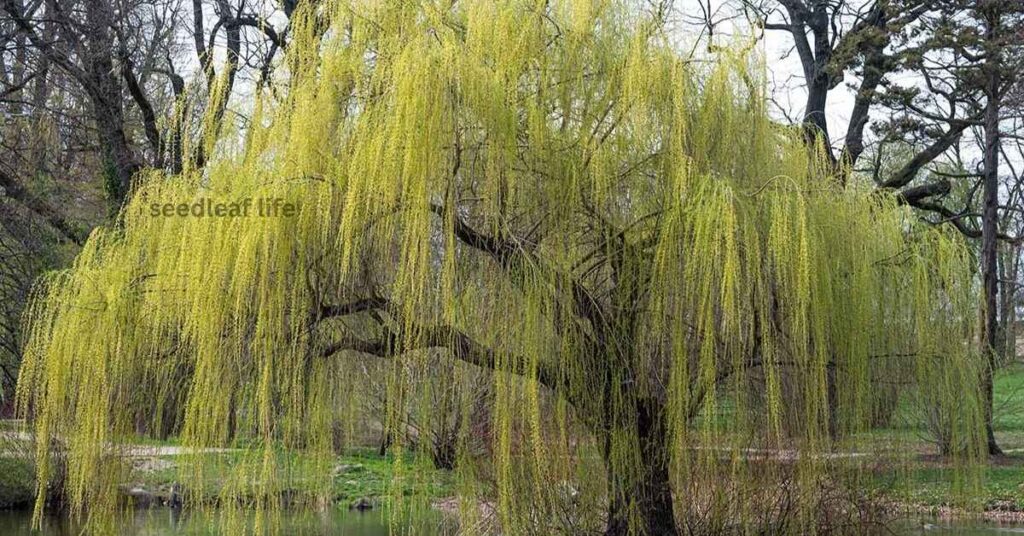
To truly appreciate the Weeping Willow lifespan, it helps to first understand this remarkable tree — its nature, growth habits, and graceful charm.
- Botanical Name: Salix babylonica
Native Region, Appearance, and Unique Features
The weeping willow lifespan—scientifically known as Salix babylonica—is one of the most graceful trees you can add to your garden. Here’s what makes it so special:
- Origin: Native to Asia, this tree has a long history of symbolizing peace and beauty.
- Loves Moist Soil: It thrives in wet, soft soil, which is why it’s often planted near ponds, lakes, and rivers.
- Elegant Appearance: Its long, drooping branches sway gently in the breeze, creating a calm and poetic scene.
- Seasonal Charm: In summer, it shines with vibrant green leaves, and in fall, those leaves turn golden yellow, adding beauty through every season.
Why Gardeners Adore This Tree-Beauty, Shade, and Fast Growth
What makes this tree so beloved is simple — stunning looks, fast growth, cooling shade, and a long lifespan that rewards years of care. For garden variety, check out Coniferous Trees with Red Berries to complement your willow
- Natural Beauty: Its graceful shape and flowing branches make it a peaceful focal point in any landscape.
- Cool Shade: The wide canopy offers refreshing shade, perfect for relaxing on sunny days.
- Fast Growth: This tree grows incredibly quickly, reaching up to 50 feet tall in just a few years.
- Improves Soil: Its strong root system helps enrich the soil and prevent erosion.
- Long Lifespan: With proper care, a weeping willow can live for 50–60 years, becoming a long-term companion in your garden.
Average Lifespan of a Weeping Willow Tree
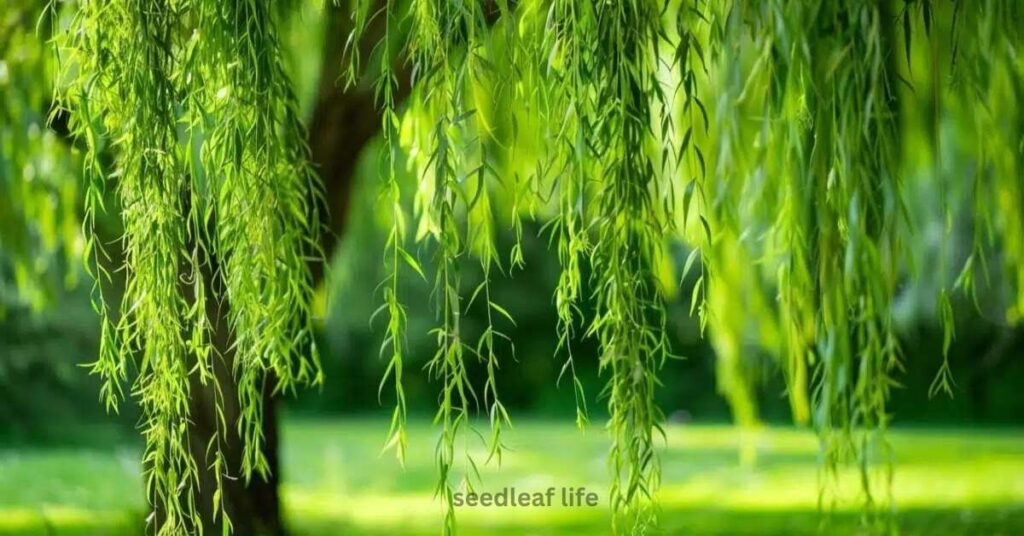
- The weeping willow lifespan usually ranges between 30 to 50 years.
- In ideal growing conditions, such as the right soil and climate, these trees can live up to 70 years.
- Picture standing under a mature Weeping Willow — its branches cascading like a soft curtain in the breeze. Knowing it has grown for decades creates a beautiful sense of peace and connection to nature.
- Compared to other trees, the Weeping Willow has a shorter lifespan:
- Oak trees can live for hundreds of years.
- Sugar maples often reach 150–200 years.
- Weeping Willows thrive in moist soil and mild climates, making them popular in gardens, parks, and near ponds or rivers.
- However, their lifespan can be shortened by:
- Root rot from overwatering or poor drainage.
- Storm damage due to their flexible but fragile branches.
- Poor soil conditions, which weaken the tree’s roots over time.
- With proper care and the right environment, your Weeping Willow can live for generations, adding shade, beauty, and calmness to your landscape.
Factors That Affect the Weeping Willow Lifespan

The weeping willow lifespan depends on more than just time — soil, sunlight, and water all play a vital role in how long this graceful tree thrives
Soil & Drainage
- The weeping willow lifespan largely depends on the soil quality and drainage.
- These trees love moist soil, but too much water can cause the roots to rot.
- The best soil is well-draining yet slightly damp, allowing roots to breathe and grow strong.
- Aim for the perfect balance — not too dry, not too soggy — to keep your willow thriving.
Sunlight & Climate
- weeping willows grow best under mild, sunny conditions.
- They prefer a balance of warmth and cool temperatures, making them ideal for temperate climates.
- Too much shade can slow growth and shorten their lifespan.
- Planting them in a sunlit, open space helps them live longer and look more vibrant.
Pests & Diseases
- Common pests like borers and aphids can weaken the tree over time.
- Fungal infections are another major threat that can affect the Weeping Willow lifespan.
- Regular inspection and early treatment go a long way in keeping the tree healthy.
- Keep an eye on leaves and bark for unusual spots, holes, or discoloration — these are early warning signs.
Maintenance & Pruning
- Proper pruning is key to extending your tree’s life.
- Poor or careless cuts can create weak points that invite disease and damage.
- Always trim dead or overlapping branches to improve air circulation.
- Gentle, regular maintenance keeps your Weeping Willow strong, stable, and graceful for years.
Water Availability
- Water plays a vital role in the Weeping Willow’s growth and health.
- These trees naturally thrive near ponds, lakes, and streams, where moisture is consistent.
- If you can replicate that moist environment in your garden, your willow will grow faster and live longer.
- Consistent watering — without overdoing it — helps maintain the perfect balance for longevity.
How to Help Your Weeping Willow Thrive for 50+ Years
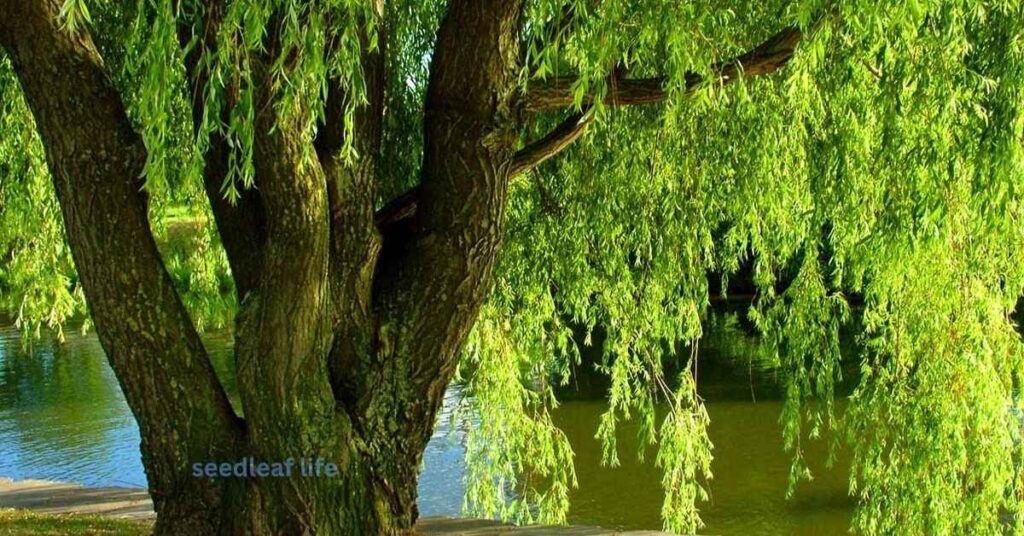
A healthy weeping willow lifespan depends on consistent care — from proper watering to pest control, small efforts lead to 50+ years of natural beauty.
Step-by-Step Care Tips
- Choose the Right Planting Spot
- Pick a location with moist, well-draining soil — not too soggy and not too dry.
- Avoid areas with heavy foot traffic, as compacted soil can damage delicate roots and shorten the weeping willow lifespan.
Maintain Consistent Watering
- During the first few years, deep and slow watering is key.
- Focus on soaking the soil so moisture reaches the roots, especially during dry spells.
Use Organic Mulch and Fertilizer
- Apply a layer of organic mulch around the base to retain moisture and improve soil quality.
- Use natural fertilizers to nourish the roots and promote steady growth.
Prune Yearly to Prevent Branch Breakage
- Schedule a yearly pruning session to remove weak or overcrowded branches.
- Proper pruning keeps the tree healthy, strong, and elegant through the years.
Treat Pests Early
- Keep an eye out for borers, aphids, and fungal issues.
- Early treatment helps prevent infestations that can weaken the tree over time.
Avoid Compacting Soil Near Roots
- Refrain from parking vehicles or walking too often near the tree’s base.
- Loose, aerated soil ensures roots can breathe and absorb nutrients effectively.
What Are the Negatives of a Weeping Willow Tree?
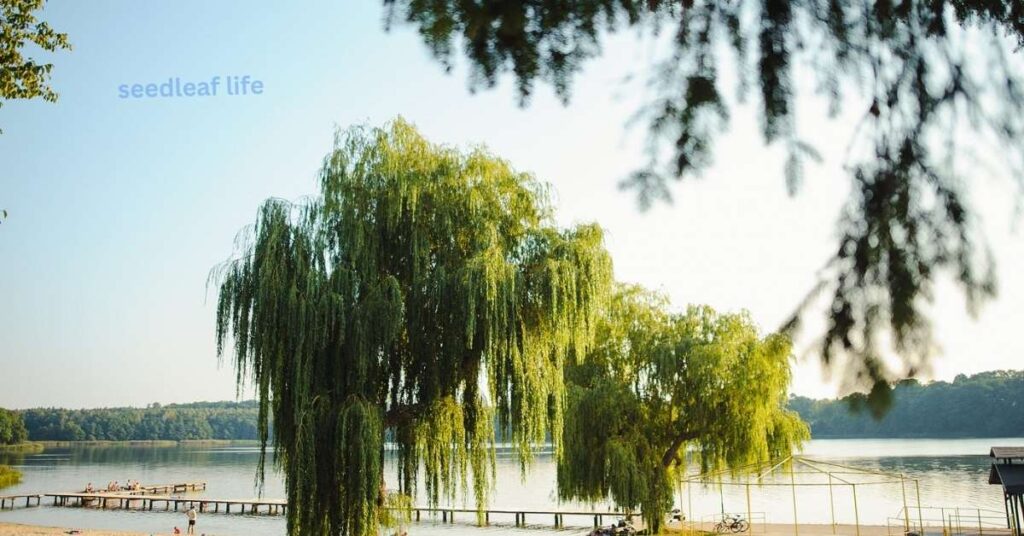
While weeping willow trees are admired for their graceful beauty, they do come with a few drawbacks that every gardener should know before planting. Understanding these challenges can help you decide if this tree is truly the right fit for your space.
Common Drawbacks
Shallow Root System
- The roots spread wide and stay close to the surface, which can damage sidewalks, foundations, and underground pipes.
- This root behavior often leads to costly repairs if planted too close to structures.
High Water Needs
- Weeping willows require a lot of moisture to stay healthy.
- They’re not suitable for dry or drought-prone regions, as their roots will aggressively seek water sources.
Shorter Lifespan
- Compared to long-living trees like oaks or maples, the weeping willow lifespan is relatively short—usually 30 to 50 years.
- They provide quick beauty but may need to be replaced sooner than other species.
Branch Breakage in Strong Winds
- The willow’s soft, flexible wood is prone to breaking during storms or high winds, which can create extra yard cleanup and potential hazards.
Requires Plenty of Space
- These trees can grow up to 50 feet tall and wide, so they need ample room to spread.
- They’re not ideal for small yards or tight spaces.
When planting a weeping willow, make sure to plant it at least 50 feet away from buildings, plumbing lines, and driveways to prevent future damage.
Are Weeping Willows Hard to Keep Alive?
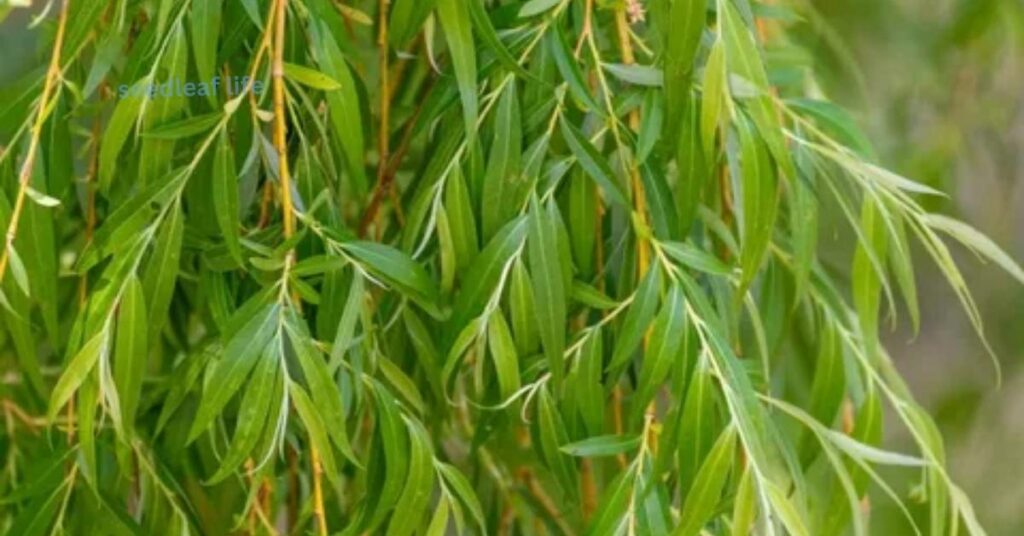
Weeping willows are not particularly hard to care for, but they do have specific needs that require attention. When planted in the right conditions, they can be both easy to grow and incredibly rewarding to maintain.
Key Points to Remember
Not Difficult, But Sensitive
- Weeping willows aren’t high-maintenance, but they’re sensitive to poor drainage and dry soil.
- Consistent moisture is crucial—they need soil that’s damp, not soaked.
Easy to Grow in the Right Environment
- These trees thrive near ponds, rivers, or other water sources.
- The closer they are to a natural moisture source, the easier they are to maintain.
Common Mistake: Planting Too Far from Water
- Many gardeners plant them too far from water, which causes roots to dry out.
- A lack of consistent moisture can drastically reduce the weeping willow lifespan.
Watch for Overwatering or Dry Roots
- Both extremes—waterlogged soil or dry roots—can stress the tree.
- Healthy balance is key to keeping your willow lush and long-lived.
Keep soil evenly moist—not soggy, not dry. Regularly check the top few inches of soil; if it feels dry, it’s time to water.
Why Has My Weeping Willow Died?
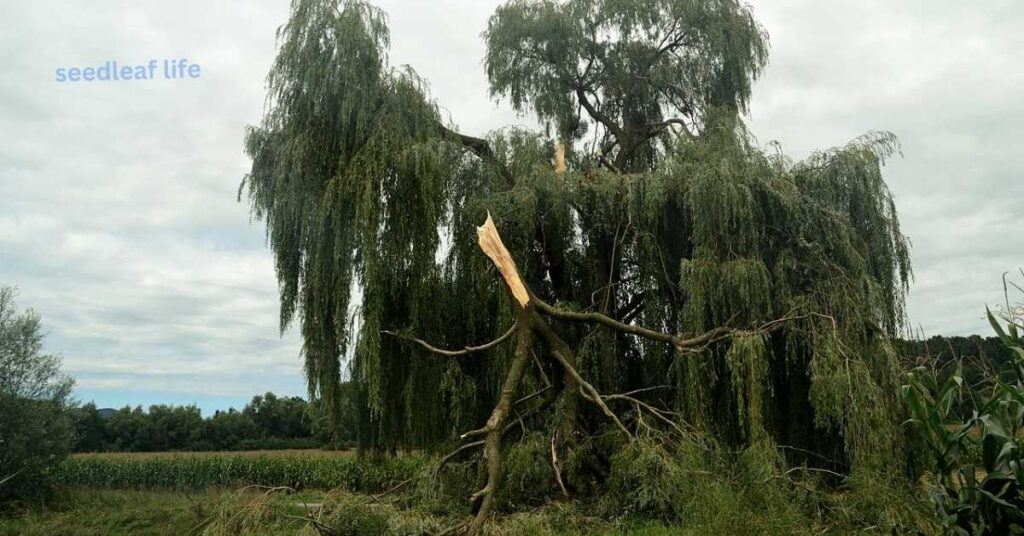
If your once-beautiful willow has started to wither or suddenly died, don’t worry—you’re not alone. There are several common reasons why this might happen, and understanding them can help you protect other trees and even extend your Weeping Willow lifespan in the future.
Possible Reasons
Root Rot from Standing Water
- Weeping willows love moisture, but too much water can cause root rot, suffocating the roots and cutting off nutrients.
Pest Infestation (Like Willow Borers)
- Insects such as borers or aphids can tunnel into the wood and weaken the tree from within.
- Left untreated, infestations can drastically shorten the Weeping Willow lifespan.
Drought Stress or Poor Watering
- Irregular watering or long dry periods can cause stress, especially in young trees.
- The roots dry out quickly, leading to leaf drop and dieback.
Fungal Infections in Roots or Branches
- Fungi thrive in damp environments and can cause decay or cankers, affecting the tree’s internal health.
- Regular inspection helps catch these early before they spread.
Storm or Wind Damage
- Strong winds can snap major limbs or uproot the tree entirely, especially if the soil is saturated or loose.
What You Can Do
- Improve Drainage — Ensure the soil drains well to prevent water from pooling around the roots.
- Prune Dead or Weak Branches — Regular pruning reduces stress and prevents further decay.
- Inspect Roots and Soil — Check for signs of rot, pests, or fungal growth and treat immediately.
- Monitor Watering Habits — Keep the soil consistently moist but not waterlogged.
By addressing these issues early, you can extend your weeping willow lifespan, keeping it healthy, green, and graceful for many more years.
How Long Does a Willow Live?
The weeping willow lifespan, known for its graceful, drooping branches, typically has a lifespan that’s shorter than some of its relatives — often living around 30 to 50 years. However, this vibrant tree can sometimes defy expectations with the right care and environment, reaching up to 70 years or more.
While it grows quickly and brings instant beauty to any landscape, rapid growth can also mean a shorter lifespan, as fast-growing trees tend to age sooner.
On the other hand, other willow species live longer. For example, the White Willow (Salix alba) can thrive for up to 80 years, showcasing the wide diversity within the willow family.
Several factors influence how long these trees live, including:
- Soil quality and drainage
- Water availability
- Climate and temperature
- Pest and disease management
With proper maintenance — regular pruning, pest control, and soil care — Weeping Willows can enrich your landscape for decades. Their beauty, shade, and symbolism make them a cherished presence in gardens and parks alike.
Quick Facts — How Long Does a Willow Live?
| Willow Type / Condition | Average Lifespan | Notes |
| General Willow Trees | 30–50 years | Typical range for most willow species. |
| White Willow (Salix alba) | Up to 80 years | One of the longest-living willow species. |
| Weeping Willow (Salix babylonica) | 30–50 years | Slightly shorter lifespan due to fast growth. |
| With Ideal Care & Conditions | Up to 70+ years | Proper watering, pruning, and pest control can extend lifespan. |
Understanding the weeping willow lifespan helps gardeners appreciate not only its fleeting beauty but also how to help it live as long and healthy a life as possible.
Common Problems That Shorten the Weeping Willow Lifespan
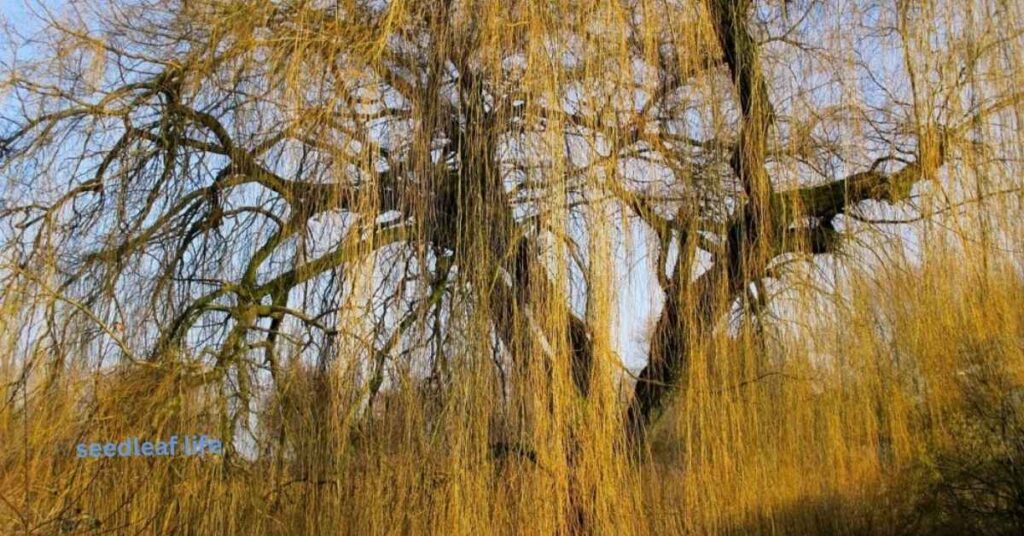
The weeping willow lifespan may seem strong, but beneath its beauty lie a few challenges every gardener should watch out for.
Root Diseases and Fungal Infections
- One major factor that affects your Weeping Willow lifespan is root diseases and fungal infections.
- These hidden threats can silently disrupt the tree’s health, blocking nutrient absorption and leading to severe decline.
- Keeping an eye on your willow’s roots is crucial — if you notice discoloration, a foul smell, or mushy areas, act quickly.
- Early treatment and improved drainage can often save the tree and restore its strength.
Improper Pruning
- Improper pruning is another common mistake that can shorten a Weeping Willow’s life. Poorly placed cuts or over-pruning can cause slow healing, making the tree vulnerable to pests and fungal infections.
- Instead, prune gently once or twice a year, removing dead or weak branches while maintaining the tree’s natural shape. This helps your willow stay healthy, balanced, and thriving.
Dry Soil or Overwatering
- Watering plays a critical role in a Weeping Willow’s health. Both overwatering and dry soil can stress the roots. Willows love moisture, but they also need well-draining soil to prevent root rot.
- Aim for consistently damp — not soggy — soil. During dry spells, increase watering frequency to keep your tree hydrated.
Soil Compaction and Lack of Oxygen
- Weeping Willows have extensive root systems that need plenty of oxygen and loose soil. Compacted soil prevents air from reaching the roots, leading to slower growth and nutrient deficiencies.
- Avoid walking or placing heavy objects near the base of your tree. Adding mulch around the base helps maintain soil structure and improves root health.
Poor Planting Location
- Planting in the wrong spot can limit your Weeping Willow’s lifespan from the start. These trees thrive near water sources and need ample space for their roots to spread.
- Avoid areas near underground pipes, sidewalks, or dry, rocky soil. Choosing the right location ensures your willow grows strong and lives for decades.
By understanding these common problems and preventing them early, you can extend your Weeping Willow’s lifespan and keep it a stunning centerpiece in your garden for many years.
Symbolism & Beauty of the Weeping Willow
The weeping willow lifespan tells a story of grace and endurance — a living symbol of peace that bends with the wind but never breaks.
A Tree of Peace and Emotional Healing
- The Weeping Willow, with its graceful, cascading branches, stands as a timeless symbol of peace, strength, and emotional healing.
- Its long, drooping limbs sway gently in the breeze, creating a serene atmosphere that invites calm and reflection.
- Often found near ponds, rivers, and lakes, the Weeping Willow enhances the beauty of any landscape while offering a tranquil space for those seeking solace.
The Weeping Willow in Literature and Culture
- In literature and culture, the Weeping Willow often represents both sorrow and resilience.
- Its ability to bend without breaking mirrors the quiet strength we carry through life’s challenges and transformations.
What the Weeping Willow Lifespan Teaches Us
- The Weeping Willow lifespan, which can range from 30 to 75 years, symbolizes endurance, renewal, and adaptability.
- Despite its delicate appearance, this tree’s ability to thrive and recover from storms reminds us that flexibility is often the strongest form of resilience.
A Living Symbol of Reflection and Growth
- Just as the Weeping Willow adapts to changing seasons, it encourages us to stay grounded through life’s ups and downs.
- Sitting beneath its shade, listening to the gentle rustle of its leaves, reminds us to find peace and balance in our own emotional journeys.
Final Thoughts
As we conclude our exploration of the weeping willow lifespan, it’s clear that this tree brings an unmatched tranquility to our lives. Though it may not live as long as many trees, its elegance leaves a lasting impression.
By committing to the proper care and maintenance, you can help your weeping willow thrive and enrich your environment for decades. This gentle giant deserves our effort to keep it healthy, allowing its unique beauty to be enjoyed by generations. So, let’s take action and give our Weeping Willows the love they need to flourish!

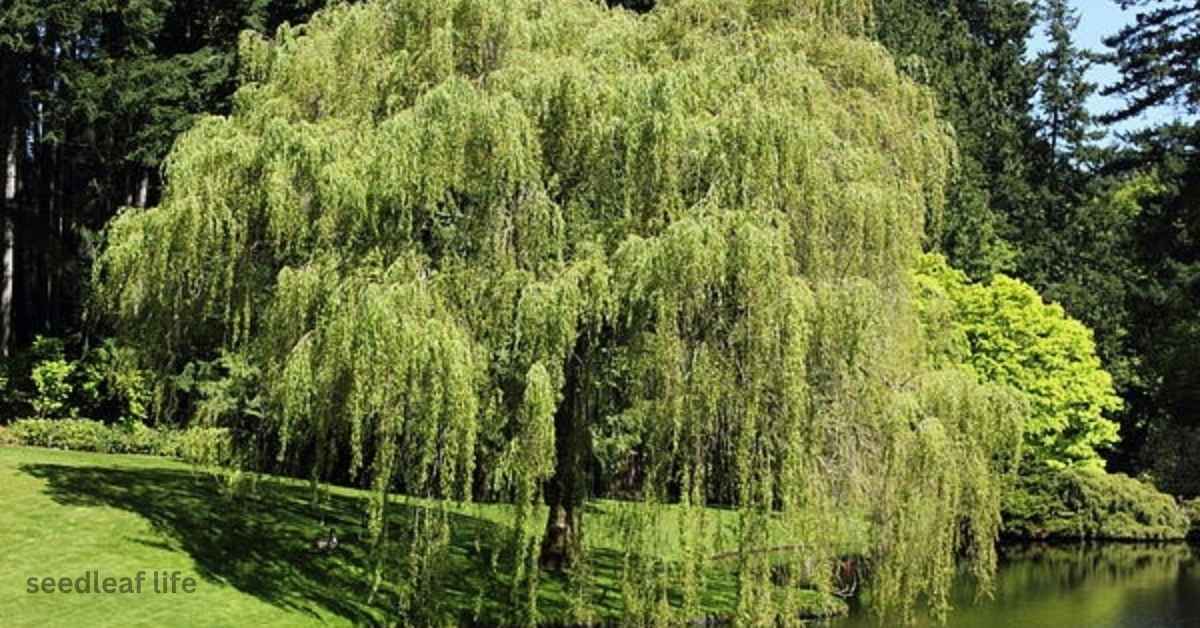
Leave a Reply
You must be logged in to post a comment.